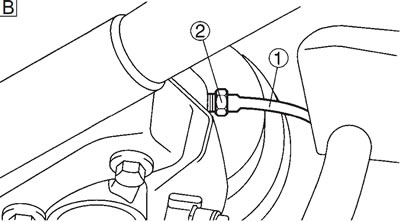Warning! Bleed the hydraulic brake system whenever: the system was disassembled, a brake hose was loosened or removed, the brake fluid level is very low, brake operation is faulty.
Note:
- Be careful not to spill any brake fluid or allow the brake master cylinder reservoir or brake fluid reservoir to overflow.
- When bleeding the hydraulic brake system, make sure that there is always enough brake fluid before applying the brake. Ignoring this precaution could allow air to enter the hydraulic brake system, considerably lengthening the bleeding procedure.
- If bleeding is difficult, it may be necessary to let the brake fluid settle for a few hours. Repeat the bleeding procedure when the tiny bubbles in the hose have disappeared.
1. Stand the motorcycle on a level surface.
Note: Place the motorcycle on a suitable stand. Make sure that the motorcycle is upright.
2. Bleed: hydraulic brake system
a. Add the recommended brake fluid to the proper level.
b. Install the diaphragm (brake master cylinder reservoir or brake fluid reservoir).
c. Connect a clear plastic hose (1) tightly to the bleed screw (2).

[A] Front | 
[B] Rear |
d. Place the other end of the hose into a container.
e. Slowly apply the brake several times.
f. Fully squeeze the brake lever or fully depress the brake pedal and hold it in position.
g. Loosen the bleed screw.
This will release the tension and cause the brake lever to contact the throttle grip or the brake pedal to fully extend.
h. Tighten the bleed screw and then release the brake lever or brake pedal.
i. Repeat steps (e) to (h) until all of the air bubbles have disappeared from the brake fluid in the plastic hose.
j. Tighten the bleed screw to specification.
- Bleed screw: 6 Nm (0.6 m·kg)
k. Fill the reservoir to the proper level. Refer to "Checking the brake fluid level".
Warning! After bleeding the hydraulic brake system, check the brake operation.
